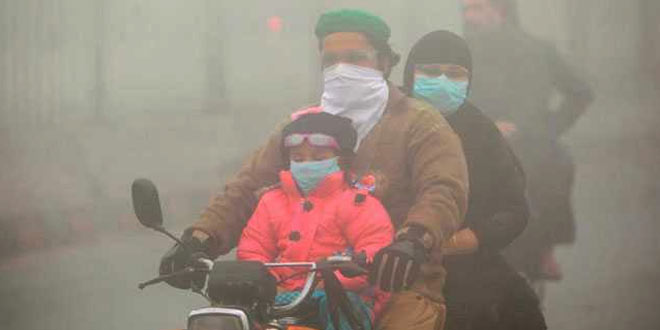New Delhi: Air, one of the essentials for an individual’s healthy living has got an adjective ‘polluted’ attached to it. The air we breathe every micro second has particulate matter (PM) – suspended particles ranging from PM10, PM2.5 to ultra-fine particles and gases like nitrogen dioxide, sulphur dioxide and ozone present in it. Because of the same, air pollution consistently ranks among the top risk factors for death worldwide. According to the State of Global Air report 2019 released on Wednesday (April 2), air pollution was the fifth highest mortality risk factor globally and was associated with about 4.9 million deaths and 147 million years of healthy life lost in 2017.
The third edition of the State of Global Air report produced annually by the Health Effects Institute (HEI) and the Institute for Health Metrics and Evaluation’s Global Burden of Disease project reveals shocking figures in regard to air pollution. The report highlights the disease burden, health impacts, and impact on life expectancy of an individual on exposure to air pollution in 2017.
Here are the top 5 findings of the State of Global Air report 2019:
1. Worldwide 92 Per Cent Of People Lived In Polluted Air
Across the world, 92 per cent of people were residing in areas exceeding World Health Organisation’s guideline for PM2.5 (fine particulate matter). Whereas, the WHO has set an average annual mean of PM2.5 at 10 μg/m3 and 24 hour mean at 25 μg/m3. The guidelines also provide interim target for concentration of PM2.5. The three suggested interim targets are as follows:
- Interim target 1: less than or equal to 35 µg/m3
- Interim target 2: less than or equal to 25 µg/m3
- Interim target 3: less than or equal to 15 µg/m3
As per the recently released report, 54 per cent of people lived in areas exceeding interim target 1, 67 per cent lived in areas unable to meet interim target 2 and 82 per cent lived in areas exceeding interim target 3.
Also Read: Poor Air Quality To Remain A Problem In India Despite Pollution Control Policies, Says Study
Analysis by Health Effects Institute
PM2.5 sources in India include household burning of solid fuels, dust from construction, roads, and other activities, industrial and power plant burning of coal, brick production, transportation, and diesel-powered equipment.

2. 60 Per Cent Of Indians Were Exposed To Household Air Pollution
3.6 billion people (47 per cent of the global population) were exposed to household air pollution caused due to the burning of solid fuels (dung, charcoal, wood, and crop residue) for cooking. In India, an estimated 846 million which is 60 per cent of the population were exposed to household air pollution in 2017.
Household air pollution contributed to 1.6 million deaths globally in 2017. India where 60 per cent of the population cooks with solid fuels, recorded the highest number of deaths that is 482,000.
Also Read: Environment Damage Behind 1 In 4 Global Deaths, Disease, Says United Nations
3. Disease Burden Due To Air Pollution – 1.2 Millions Deaths In India
Increase in air pollution is directly linked to increase in respiratory diseases like chronic obstructive pulmonary disease (COPD), asthma, lung cancer and others. Of the 4.9 million deaths due to air pollution globally, 1.2 million belongs to India only.
In 2017, globally, 41 per cent of deaths from COPD, 19 per cent of deaths from lung cancer, 16 from ischemic heart disease, 11 per cent from stroke, 35 per cent from lower-respiratory infection and 20 per cent from diabetes are attributed to air pollution.
Long term exposure to PM2.5 contributed to 2.9 million deaths. This implies that 5.2 per cent of global deaths (4.9 million) were due to PM2.5 itself. The highest number of deaths due to exposure to PM2.5 has been recorded in China (852,000 deaths) and India (673,000 deaths), which are also two of the most populated countries.
4. 31 Per Cent Of Global Deaths On Exposure To Ozone Were From India
Ozone is both a harmful and beneficial gas. When it is up in the atmosphere, it acts as a boon; protecting Earth from harmful UV (ultraviolet) radiation. Whereas, when it is in the troposphere (lowest layer of Earth’s atmosphere), it plays a role of greenhouse gas and affect human health adversely.
Globally 472,000 early deaths were recorded in 2017, courtesy long term exposure to ozone. 31 per cent of these deaths are associated with India.
Also Read: Air Pollution: Raw Materials Behind Half Of Global Greenhouse Gas Emissions, Says United Nations
5. How Air Pollution Impacted Life Expectancy In 2017
Worldwide life expectancy was reduced by a year and 8 months on average, which actually matched that of smoking. This implies, in the presence of air pollution, a child born today will die 20 months sooner than would be expected in the absence of air pollution.
NDTV – Dettol Banega Swachh India campaign lends support to the Government of India’s Swachh Bharat Mission (SBM). Helmed by Campaign Ambassador Amitabh Bachchan, the campaign aims to spread awareness about hygiene and sanitation, the importance of building toilets and making India open defecation free (ODF) by October 2019, a target set by Prime Minister Narendra Modi, when he launched Swachh Bharat Abhiyan in 2014. Over the years, the campaign has widened its scope to cover issues like air pollution, waste management, plastic ban, manual scavenging and menstrual hygiene. The campaign has also focused extensively on marine pollution, clean Ganga Project and rejuvenation of Yamuna, two of India’s major river bodies.






























